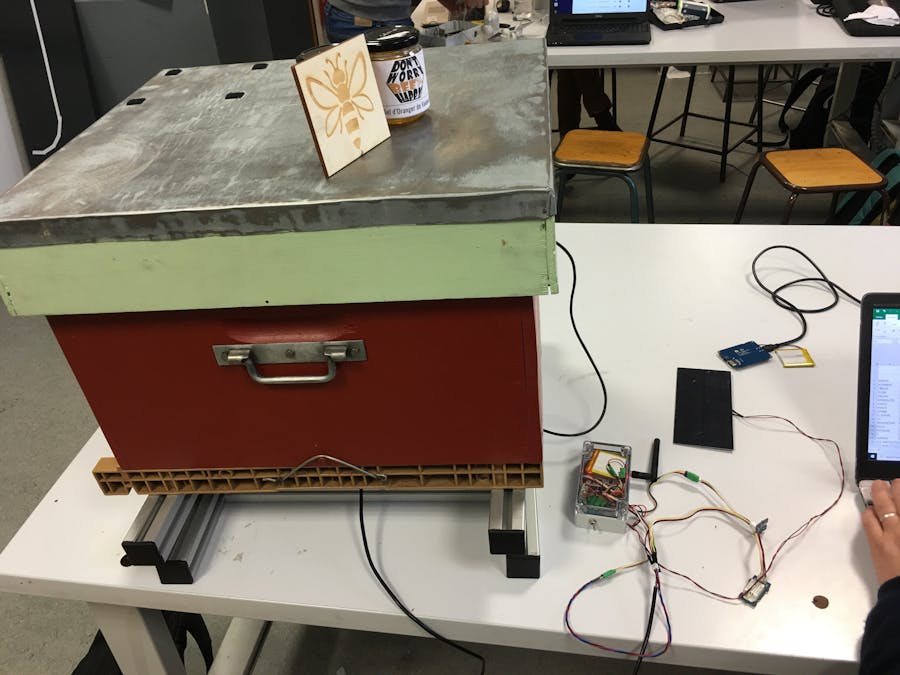As part of our studies at Polytech Sorbonne, Sorbonne Université (ex Polytech Paris UPMC, Université Pierre-et-Marie-Curie), our teacher gave us a project which consists in retrieving air moisture, temperature, detecting the presence of the queen bee and gives the weight of the bee hive. The goal is to monitor on site and online the hive’s environment.
Temperature / humidity acquisition
The temperature of a hive and its humidity says a lot about its condition. It is possible to know if the bees are still active or if the temperature inside the hive is insufficient for the survival of the bees. To collect this information, we use a DHT22 sensor which captures both the temperature and humidity of the air.
Mass acquisition
The weight of the hive is an important factor for the beekeeper. It lets you know if the hive is healthy and it also lets the beekeeper know when to harvest honey. To weigh the hive, we opted for a system that contains a strain gauge (sensor) coupled with an HX771 amplifier. This allows loads of up to 200kg to be weighed while being reliable under unfavorable climatic conditions.
Sound acquisition / processing
The sound produced by the colony is a precious source of information for the beekeeper. Once the audio signal has been captured and processed, the program embedded in the microcontroller will be able to deduce two crucial pieces of information:
- presence or not of the queen in the colony
- detection of the start of swarming: when the colony becomes too large, the queen and part of the colony leaves in search of a place to build a new hive. It is useful for the beekeeper to know when the swarming is going to take place so that he prevents it and thus keeps his entire colony.
These two pieces of information are detectable by the frequency of the sound that the colony produces. If one of these two frequencies is detected, it is possible to send the queen presence or swarming information to the remote web interface.
At regular time intervals, the system picks up the sound from the hive using a microphone / amplifier and calculates the FFT (Fourier Transform) in order to obtain all the frequencies contained in the audio signal. It then remains to be seen whether the characteristic frequencies sought are in this set of frequencies.
Power management
The system must be self-sufficient in energy. To accomplish this, we power the STM32 card using a solar panel and a Lithium battery which will take over when the sun is not enough. A power card serves as an intermediary between the 3 components, the latter was designed on the basis of the Lipo Rider card in less energy.
The main goal of the connected hive project is to develop a swarm monitoring system. All the information will be taken directly on or in the hive, then send by wireless transmission module in order to view this data on a clear online interface.
Once the project is completed, it will above all serve beekeepers to optimize their harvest while ensuring the sustainability of the hive
We will use IoT technology for wireless data transmission and services from Sigfox. Sigfox limiting the sending of messages to 140 per day we will have to make sure to send messages every 10 minutes.
As for data display, the Ubidots platform allows you to view the information retrieved by the Sigfox service on any medium via the Web.
To develop our project, we used Mbed, a collaborative online programming software that helped us finish our project. The special part of this website is that you can edit your code wherever you want.
Another advantage of MBED is the possibility to find a great number of microcontrollers libraries.
Here are the 3 main parts of our program :
- measure of the weight
- measure of temperature and humidity with the DHT22
- detection of the sound of the queen bee before swarming
For the latter, we will explain what we do to detect the sound of the queen bee :
- we sample the surrounding sound of the bee hive with our microphone
- we calculate the FFT of this sound
- we look at the amplitude of the frequencies in the FFT that interest us
The frequency we are interested in are around 380Hz. We found this value by listening to youtube videos where the queen bee makes this sound.
When the queen bee makes her sound, we see that the amplitude around 380Hz are higher than when she doesn't. We simply have to find a threshold experimentally so that we can consider that when the amplitude around 380Hz is higher than that threshold than it means that the queen bee is making her sound.
We are constantly listening for the presence of the queen bee, but when we send the message for the presence of the queen bee, we stop listening.
2) The cardFinally, we chose Altium and Kicad to create our PCB. Kicad is also a free tool and it’s very friendly for student, Altium need a license, there are many useful libraries, it’s very helpful to check the component is adaptable or not.
KiCad
The last part is about how to package our system. To be original, we have drawn our own box in 3D with Cad, an open source software that allows us to draw our box easily and in details.
3D box:
We also designed a box for the sensor humidity and the solar panel.
System complete:








_4YUDWziWQ8.png?auto=compress%2Cformat&w=48&h=48&fit=fill&bg=ffffff)









_Ujn5WoVOOu.png?auto=compress%2Cformat&w=40&h=40&fit=fillmax&bg=fff&dpr=2)

_3u05Tpwasz.png?auto=compress%2Cformat&w=40&h=40&fit=fillmax&bg=fff&dpr=2)
Comments
Please log in or sign up to comment.